MGT4700 Essay: Literature Review on Curiosity, Leaders, and Followers
VerifiedAdded on 2022/12/28
|8
|2214
|96
Essay
AI Summary
This essay presents a literature review on two key themes: leadership and curiosity, drawing on various scholarly sources. The essay begins by defining leadership and exploring different leadership styles, their impacts on organizational performance, and the role of followers. It also examines the importance of leadership theories, such as the great man theory and contingency theory. The second theme, curiosity, is discussed in terms of its impact on learning, innovation, and decision-making within organizations. The essay explores the benefits of curiosity, such as reduced decision-making errors and improved team efforts, while also addressing potential drawbacks like slower decision-making processes. It also highlights strategies to promote curiosity in the workplace and the barriers that may hinder it. The essay concludes by summarizing the critical analysis of the two themes and their implications for organizational success, emphasizing the importance of both effective leadership and employee curiosity.
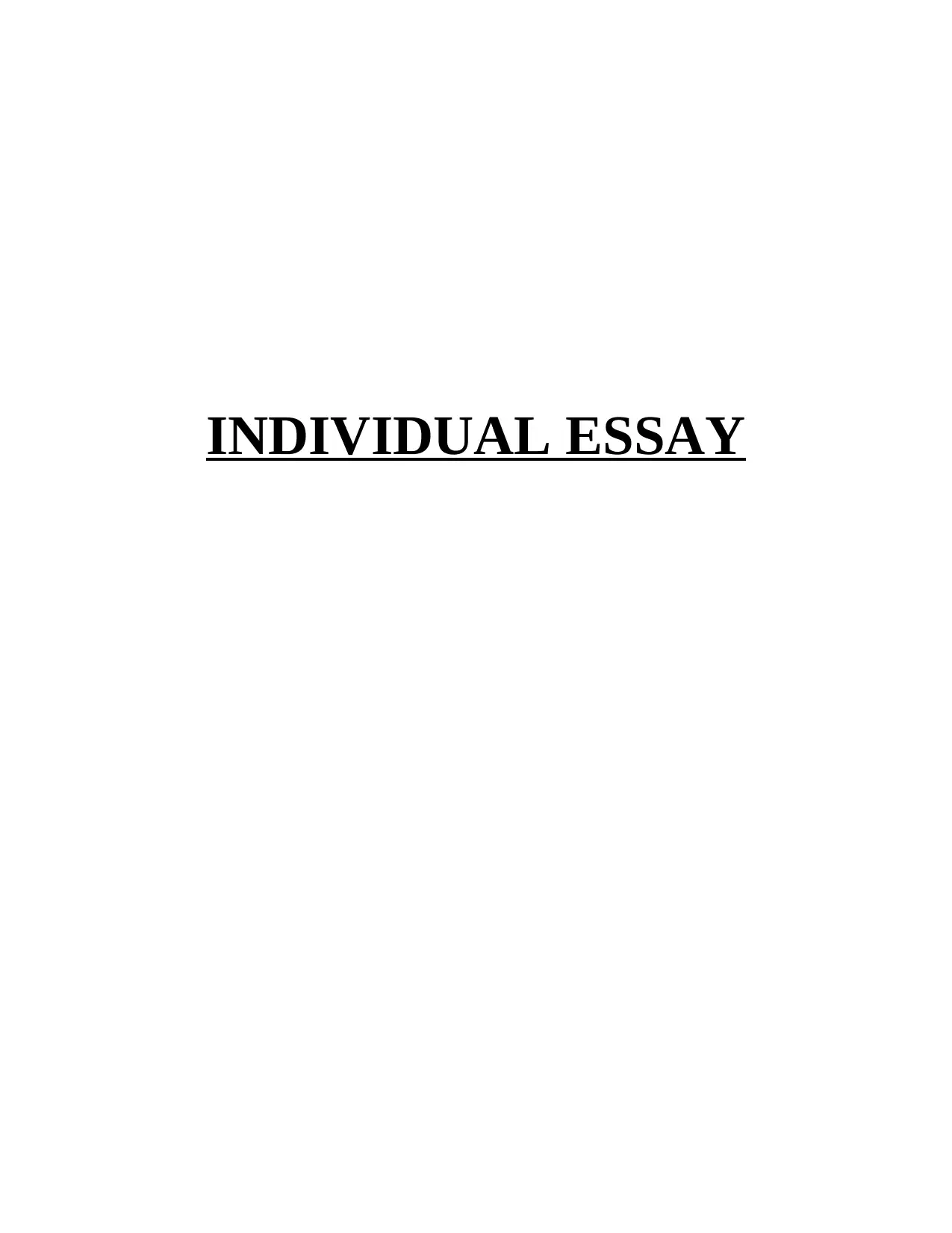
INDIVIDUAL ESSAY
Paraphrase This Document
Need a fresh take? Get an instant paraphrase of this document with our AI Paraphraser
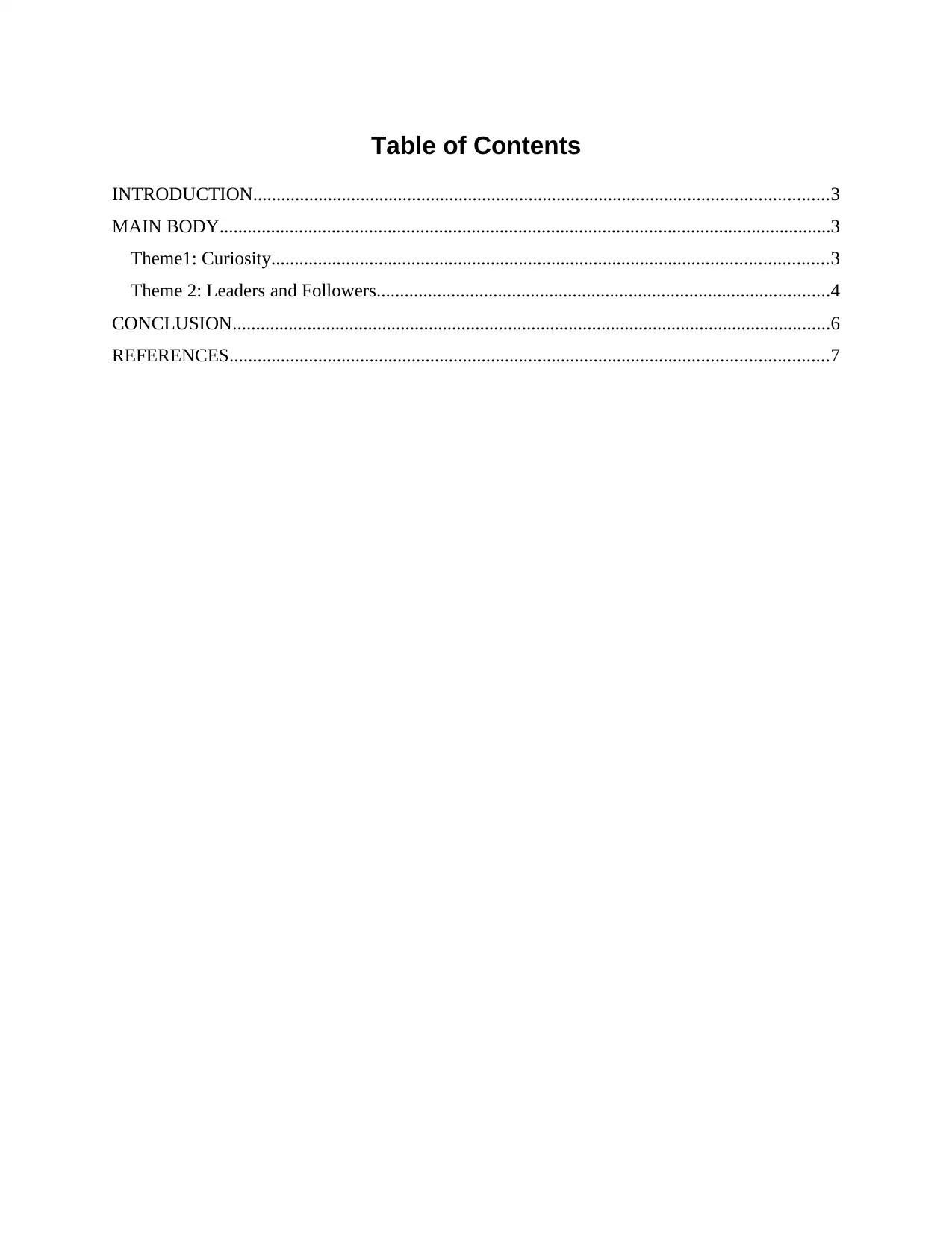
Table of Contents
INTRODUCTION...........................................................................................................................3
MAIN BODY...................................................................................................................................3
Theme1: Curiosity.......................................................................................................................3
Theme 2: Leaders and Followers.................................................................................................4
CONCLUSION................................................................................................................................6
REFERENCES................................................................................................................................7
INTRODUCTION...........................................................................................................................3
MAIN BODY...................................................................................................................................3
Theme1: Curiosity.......................................................................................................................3
Theme 2: Leaders and Followers.................................................................................................4
CONCLUSION................................................................................................................................6
REFERENCES................................................................................................................................7
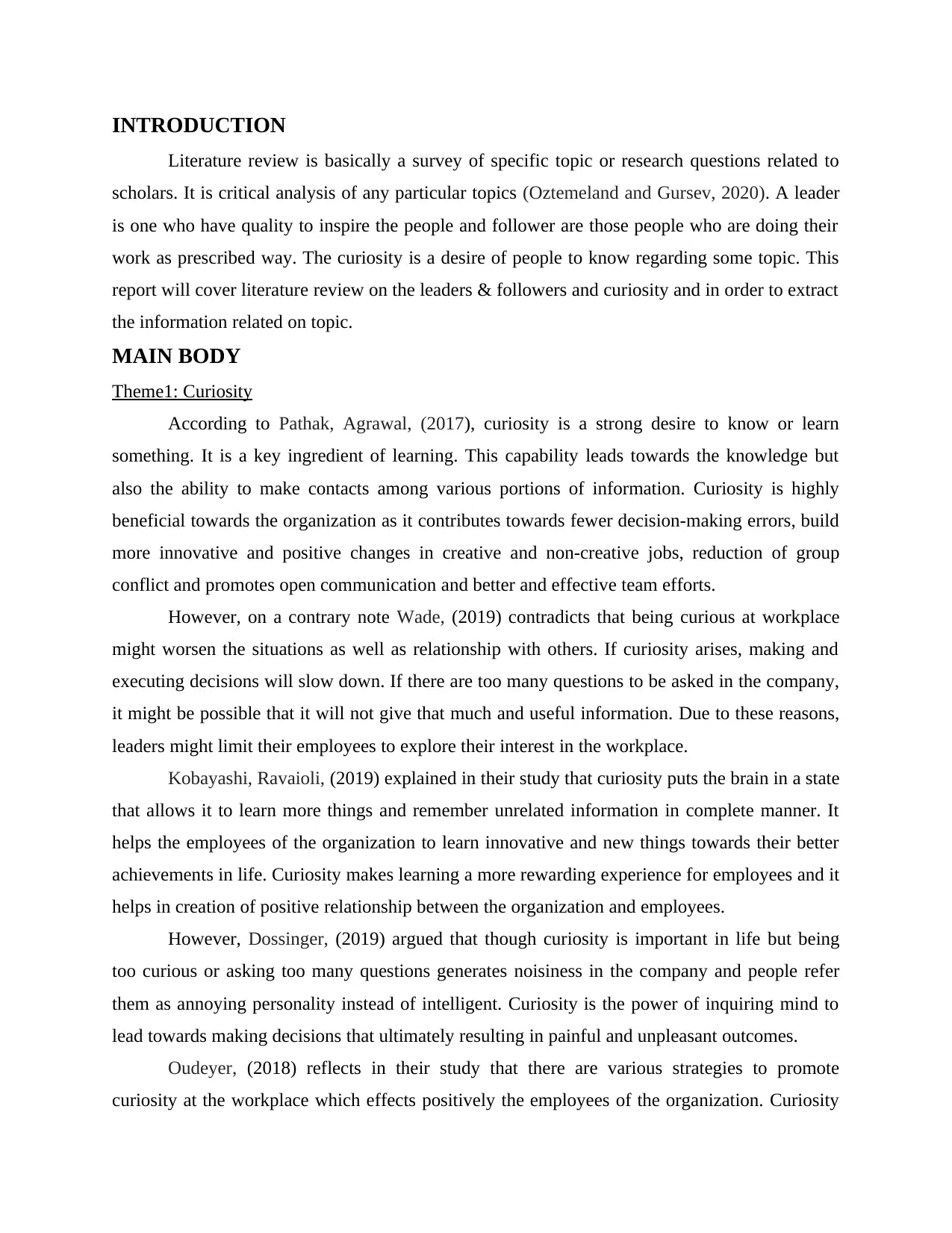
INTRODUCTION
Literature review is basically a survey of specific topic or research questions related to
scholars. It is critical analysis of any particular topics (Oztemeland and Gursev, 2020). A leader
is one who have quality to inspire the people and follower are those people who are doing their
work as prescribed way. The curiosity is a desire of people to know regarding some topic. This
report will cover literature review on the leaders & followers and curiosity and in order to extract
the information related on topic.
MAIN BODY
Theme1: Curiosity
According to Pathak, Agrawal, (2017), curiosity is a strong desire to know or learn
something. It is a key ingredient of learning. This capability leads towards the knowledge but
also the ability to make contacts among various portions of information. Curiosity is highly
beneficial towards the organization as it contributes towards fewer decision-making errors, build
more innovative and positive changes in creative and non-creative jobs, reduction of group
conflict and promotes open communication and better and effective team efforts.
However, on a contrary note Wade, (2019) contradicts that being curious at workplace
might worsen the situations as well as relationship with others. If curiosity arises, making and
executing decisions will slow down. If there are too many questions to be asked in the company,
it might be possible that it will not give that much and useful information. Due to these reasons,
leaders might limit their employees to explore their interest in the workplace.
Kobayashi, Ravaioli, (2019) explained in their study that curiosity puts the brain in a state
that allows it to learn more things and remember unrelated information in complete manner. It
helps the employees of the organization to learn innovative and new things towards their better
achievements in life. Curiosity makes learning a more rewarding experience for employees and it
helps in creation of positive relationship between the organization and employees.
However, Dossinger, (2019) argued that though curiosity is important in life but being
too curious or asking too many questions generates noisiness in the company and people refer
them as annoying personality instead of intelligent. Curiosity is the power of inquiring mind to
lead towards making decisions that ultimately resulting in painful and unpleasant outcomes.
Oudeyer, (2018) reflects in their study that there are various strategies to promote
curiosity at the workplace which effects positively the employees of the organization. Curiosity
Literature review is basically a survey of specific topic or research questions related to
scholars. It is critical analysis of any particular topics (Oztemeland and Gursev, 2020). A leader
is one who have quality to inspire the people and follower are those people who are doing their
work as prescribed way. The curiosity is a desire of people to know regarding some topic. This
report will cover literature review on the leaders & followers and curiosity and in order to extract
the information related on topic.
MAIN BODY
Theme1: Curiosity
According to Pathak, Agrawal, (2017), curiosity is a strong desire to know or learn
something. It is a key ingredient of learning. This capability leads towards the knowledge but
also the ability to make contacts among various portions of information. Curiosity is highly
beneficial towards the organization as it contributes towards fewer decision-making errors, build
more innovative and positive changes in creative and non-creative jobs, reduction of group
conflict and promotes open communication and better and effective team efforts.
However, on a contrary note Wade, (2019) contradicts that being curious at workplace
might worsen the situations as well as relationship with others. If curiosity arises, making and
executing decisions will slow down. If there are too many questions to be asked in the company,
it might be possible that it will not give that much and useful information. Due to these reasons,
leaders might limit their employees to explore their interest in the workplace.
Kobayashi, Ravaioli, (2019) explained in their study that curiosity puts the brain in a state
that allows it to learn more things and remember unrelated information in complete manner. It
helps the employees of the organization to learn innovative and new things towards their better
achievements in life. Curiosity makes learning a more rewarding experience for employees and it
helps in creation of positive relationship between the organization and employees.
However, Dossinger, (2019) argued that though curiosity is important in life but being
too curious or asking too many questions generates noisiness in the company and people refer
them as annoying personality instead of intelligent. Curiosity is the power of inquiring mind to
lead towards making decisions that ultimately resulting in painful and unpleasant outcomes.
Oudeyer, (2018) reflects in their study that there are various strategies to promote
curiosity at the workplace which effects positively the employees of the organization. Curiosity
⊘ This is a preview!⊘
Do you want full access?
Subscribe today to unlock all pages.

Trusted by 1+ million students worldwide
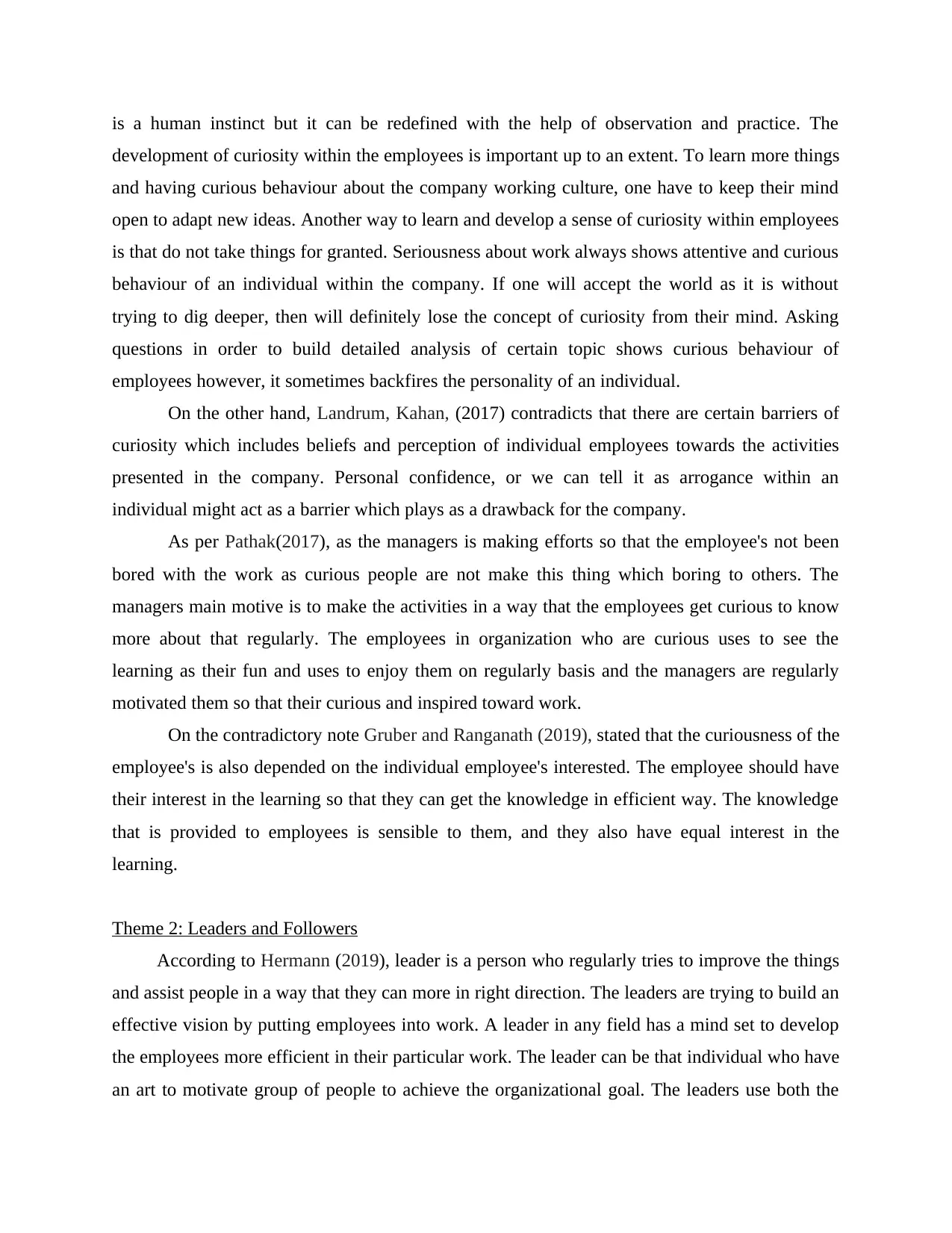
is a human instinct but it can be redefined with the help of observation and practice. The
development of curiosity within the employees is important up to an extent. To learn more things
and having curious behaviour about the company working culture, one have to keep their mind
open to adapt new ideas. Another way to learn and develop a sense of curiosity within employees
is that do not take things for granted. Seriousness about work always shows attentive and curious
behaviour of an individual within the company. If one will accept the world as it is without
trying to dig deeper, then will definitely lose the concept of curiosity from their mind. Asking
questions in order to build detailed analysis of certain topic shows curious behaviour of
employees however, it sometimes backfires the personality of an individual.
On the other hand, Landrum, Kahan, (2017) contradicts that there are certain barriers of
curiosity which includes beliefs and perception of individual employees towards the activities
presented in the company. Personal confidence, or we can tell it as arrogance within an
individual might act as a barrier which plays as a drawback for the company.
As per Pathak(2017), as the managers is making efforts so that the employee's not been
bored with the work as curious people are not make this thing which boring to others. The
managers main motive is to make the activities in a way that the employees get curious to know
more about that regularly. The employees in organization who are curious uses to see the
learning as their fun and uses to enjoy them on regularly basis and the managers are regularly
motivated them so that their curious and inspired toward work.
On the contradictory note Gruber and Ranganath (2019), stated that the curiousness of the
employee's is also depended on the individual employee's interested. The employee should have
their interest in the learning so that they can get the knowledge in efficient way. The knowledge
that is provided to employees is sensible to them, and they also have equal interest in the
learning.
Theme 2: Leaders and Followers
According to Hermann (2019), leader is a person who regularly tries to improve the things
and assist people in a way that they can more in right direction. The leaders are trying to build an
effective vision by putting employees into work. A leader in any field has a mind set to develop
the employees more efficient in their particular work. The leader can be that individual who have
an art to motivate group of people to achieve the organizational goal. The leaders use both the
development of curiosity within the employees is important up to an extent. To learn more things
and having curious behaviour about the company working culture, one have to keep their mind
open to adapt new ideas. Another way to learn and develop a sense of curiosity within employees
is that do not take things for granted. Seriousness about work always shows attentive and curious
behaviour of an individual within the company. If one will accept the world as it is without
trying to dig deeper, then will definitely lose the concept of curiosity from their mind. Asking
questions in order to build detailed analysis of certain topic shows curious behaviour of
employees however, it sometimes backfires the personality of an individual.
On the other hand, Landrum, Kahan, (2017) contradicts that there are certain barriers of
curiosity which includes beliefs and perception of individual employees towards the activities
presented in the company. Personal confidence, or we can tell it as arrogance within an
individual might act as a barrier which plays as a drawback for the company.
As per Pathak(2017), as the managers is making efforts so that the employee's not been
bored with the work as curious people are not make this thing which boring to others. The
managers main motive is to make the activities in a way that the employees get curious to know
more about that regularly. The employees in organization who are curious uses to see the
learning as their fun and uses to enjoy them on regularly basis and the managers are regularly
motivated them so that their curious and inspired toward work.
On the contradictory note Gruber and Ranganath (2019), stated that the curiousness of the
employee's is also depended on the individual employee's interested. The employee should have
their interest in the learning so that they can get the knowledge in efficient way. The knowledge
that is provided to employees is sensible to them, and they also have equal interest in the
learning.
Theme 2: Leaders and Followers
According to Hermann (2019), leader is a person who regularly tries to improve the things
and assist people in a way that they can more in right direction. The leaders are trying to build an
effective vision by putting employees into work. A leader in any field has a mind set to develop
the employees more efficient in their particular work. The leader can be that individual who have
an art to motivate group of people to achieve the organizational goal. The leaders use both the
Paraphrase This Document
Need a fresh take? Get an instant paraphrase of this document with our AI Paraphraser
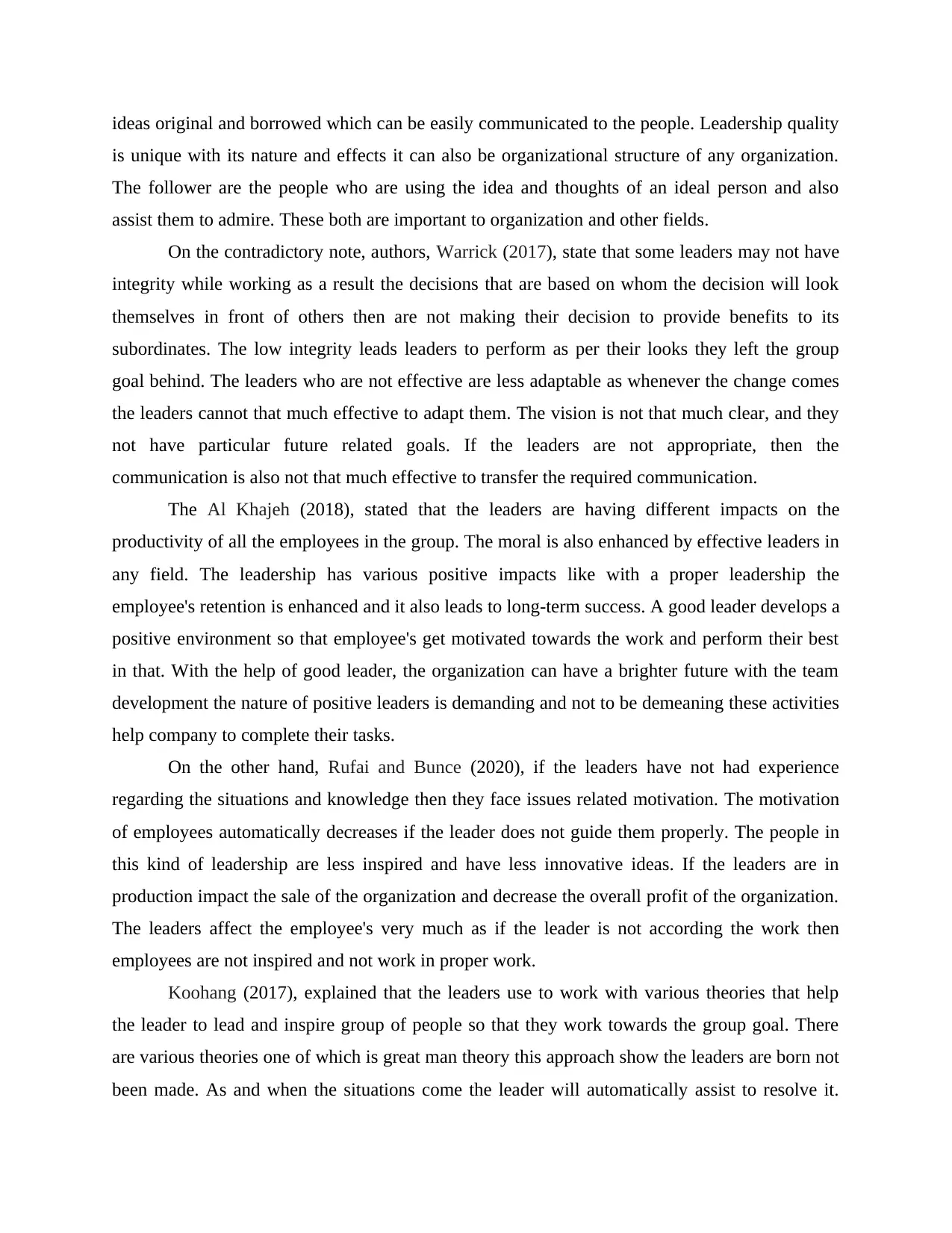
ideas original and borrowed which can be easily communicated to the people. Leadership quality
is unique with its nature and effects it can also be organizational structure of any organization.
The follower are the people who are using the idea and thoughts of an ideal person and also
assist them to admire. These both are important to organization and other fields.
On the contradictory note, authors, Warrick (2017), state that some leaders may not have
integrity while working as a result the decisions that are based on whom the decision will look
themselves in front of others then are not making their decision to provide benefits to its
subordinates. The low integrity leads leaders to perform as per their looks they left the group
goal behind. The leaders who are not effective are less adaptable as whenever the change comes
the leaders cannot that much effective to adapt them. The vision is not that much clear, and they
not have particular future related goals. If the leaders are not appropriate, then the
communication is also not that much effective to transfer the required communication.
The Al Khajeh (2018), stated that the leaders are having different impacts on the
productivity of all the employees in the group. The moral is also enhanced by effective leaders in
any field. The leadership has various positive impacts like with a proper leadership the
employee's retention is enhanced and it also leads to long-term success. A good leader develops a
positive environment so that employee's get motivated towards the work and perform their best
in that. With the help of good leader, the organization can have a brighter future with the team
development the nature of positive leaders is demanding and not to be demeaning these activities
help company to complete their tasks.
On the other hand, Rufai and Bunce (2020), if the leaders have not had experience
regarding the situations and knowledge then they face issues related motivation. The motivation
of employees automatically decreases if the leader does not guide them properly. The people in
this kind of leadership are less inspired and have less innovative ideas. If the leaders are in
production impact the sale of the organization and decrease the overall profit of the organization.
The leaders affect the employee's very much as if the leader is not according the work then
employees are not inspired and not work in proper work.
Koohang (2017), explained that the leaders use to work with various theories that help
the leader to lead and inspire group of people so that they work towards the group goal. There
are various theories one of which is great man theory this approach show the leaders are born not
been made. As and when the situations come the leader will automatically assist to resolve it.
is unique with its nature and effects it can also be organizational structure of any organization.
The follower are the people who are using the idea and thoughts of an ideal person and also
assist them to admire. These both are important to organization and other fields.
On the contradictory note, authors, Warrick (2017), state that some leaders may not have
integrity while working as a result the decisions that are based on whom the decision will look
themselves in front of others then are not making their decision to provide benefits to its
subordinates. The low integrity leads leaders to perform as per their looks they left the group
goal behind. The leaders who are not effective are less adaptable as whenever the change comes
the leaders cannot that much effective to adapt them. The vision is not that much clear, and they
not have particular future related goals. If the leaders are not appropriate, then the
communication is also not that much effective to transfer the required communication.
The Al Khajeh (2018), stated that the leaders are having different impacts on the
productivity of all the employees in the group. The moral is also enhanced by effective leaders in
any field. The leadership has various positive impacts like with a proper leadership the
employee's retention is enhanced and it also leads to long-term success. A good leader develops a
positive environment so that employee's get motivated towards the work and perform their best
in that. With the help of good leader, the organization can have a brighter future with the team
development the nature of positive leaders is demanding and not to be demeaning these activities
help company to complete their tasks.
On the other hand, Rufai and Bunce (2020), if the leaders have not had experience
regarding the situations and knowledge then they face issues related motivation. The motivation
of employees automatically decreases if the leader does not guide them properly. The people in
this kind of leadership are less inspired and have less innovative ideas. If the leaders are in
production impact the sale of the organization and decrease the overall profit of the organization.
The leaders affect the employee's very much as if the leader is not according the work then
employees are not inspired and not work in proper work.
Koohang (2017), explained that the leaders use to work with various theories that help
the leader to lead and inspire group of people so that they work towards the group goal. There
are various theories one of which is great man theory this approach show the leaders are born not
been made. As and when the situations come the leader will automatically assist to resolve it.
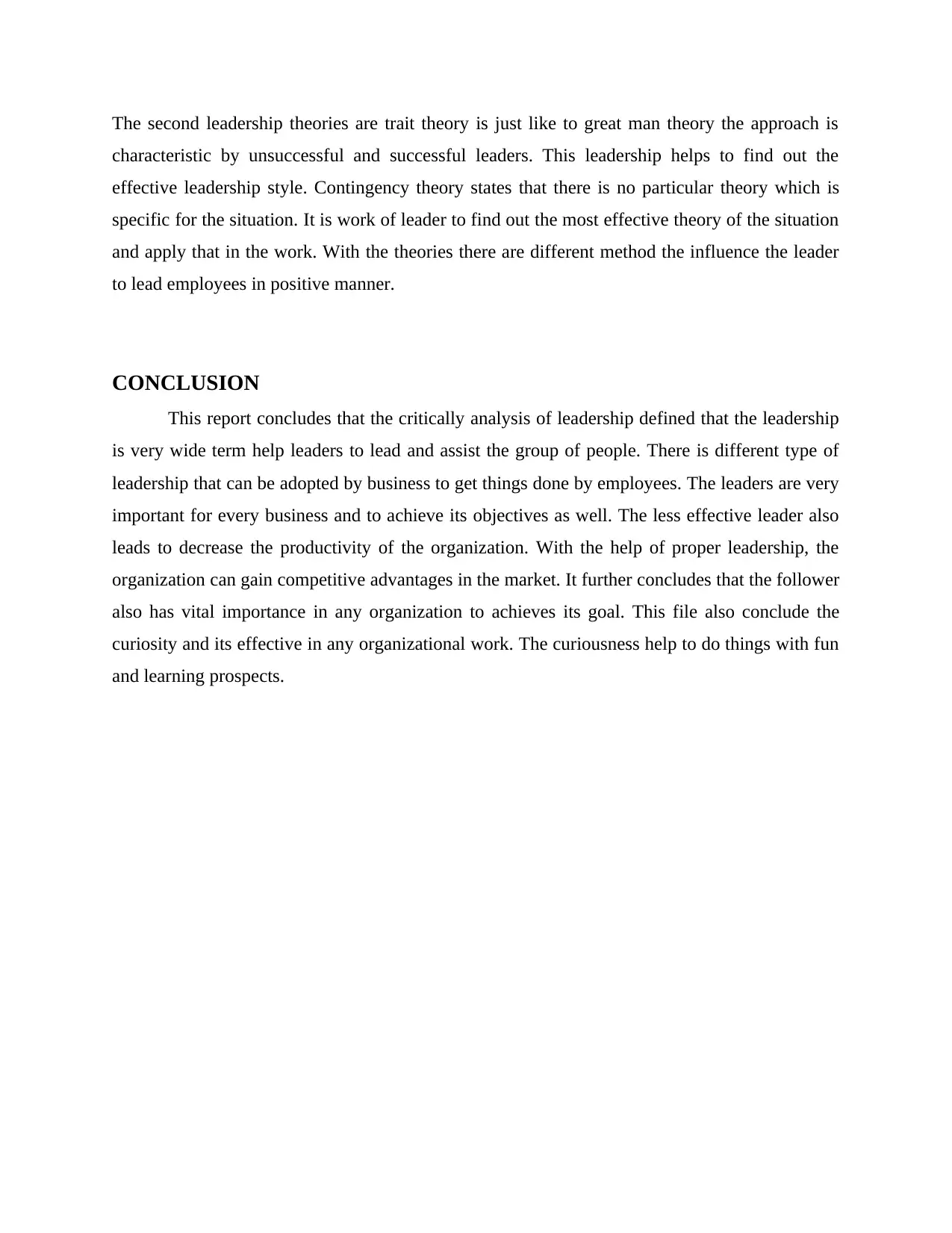
The second leadership theories are trait theory is just like to great man theory the approach is
characteristic by unsuccessful and successful leaders. This leadership helps to find out the
effective leadership style. Contingency theory states that there is no particular theory which is
specific for the situation. It is work of leader to find out the most effective theory of the situation
and apply that in the work. With the theories there are different method the influence the leader
to lead employees in positive manner.
CONCLUSION
This report concludes that the critically analysis of leadership defined that the leadership
is very wide term help leaders to lead and assist the group of people. There is different type of
leadership that can be adopted by business to get things done by employees. The leaders are very
important for every business and to achieve its objectives as well. The less effective leader also
leads to decrease the productivity of the organization. With the help of proper leadership, the
organization can gain competitive advantages in the market. It further concludes that the follower
also has vital importance in any organization to achieves its goal. This file also conclude the
curiosity and its effective in any organizational work. The curiousness help to do things with fun
and learning prospects.
characteristic by unsuccessful and successful leaders. This leadership helps to find out the
effective leadership style. Contingency theory states that there is no particular theory which is
specific for the situation. It is work of leader to find out the most effective theory of the situation
and apply that in the work. With the theories there are different method the influence the leader
to lead employees in positive manner.
CONCLUSION
This report concludes that the critically analysis of leadership defined that the leadership
is very wide term help leaders to lead and assist the group of people. There is different type of
leadership that can be adopted by business to get things done by employees. The leaders are very
important for every business and to achieve its objectives as well. The less effective leader also
leads to decrease the productivity of the organization. With the help of proper leadership, the
organization can gain competitive advantages in the market. It further concludes that the follower
also has vital importance in any organization to achieves its goal. This file also conclude the
curiosity and its effective in any organizational work. The curiousness help to do things with fun
and learning prospects.
⊘ This is a preview!⊘
Do you want full access?
Subscribe today to unlock all pages.

Trusted by 1+ million students worldwide
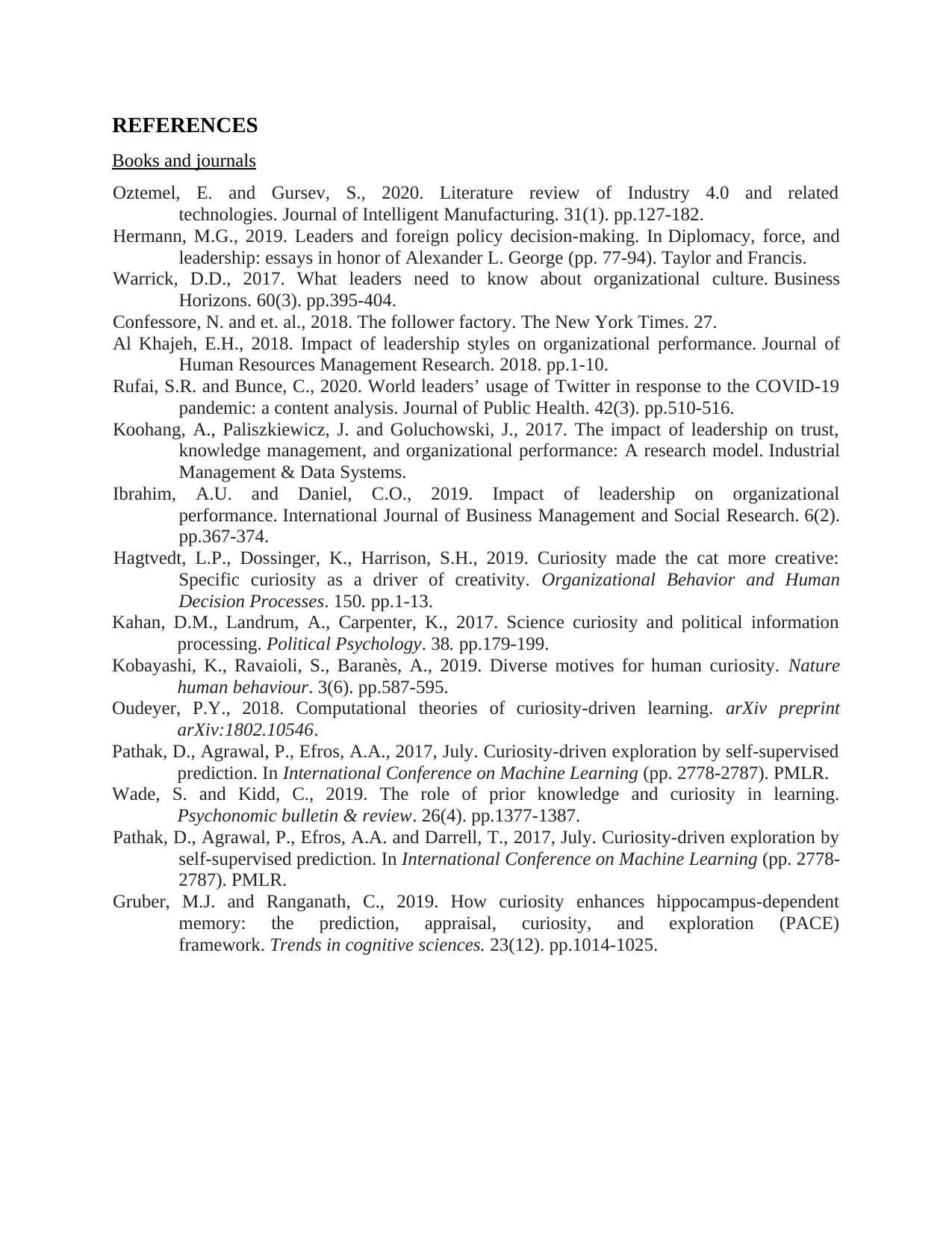
REFERENCES
Books and journals
Oztemel, E. and Gursev, S., 2020. Literature review of Industry 4.0 and related
technologies. Journal of Intelligent Manufacturing. 31(1). pp.127-182.
Hermann, M.G., 2019. Leaders and foreign policy decision-making. In Diplomacy, force, and
leadership: essays in honor of Alexander L. George (pp. 77-94). Taylor and Francis.
Warrick, D.D., 2017. What leaders need to know about organizational culture. Business
Horizons. 60(3). pp.395-404.
Confessore, N. and et. al., 2018. The follower factory. The New York Times. 27.
Al Khajeh, E.H., 2018. Impact of leadership styles on organizational performance. Journal of
Human Resources Management Research. 2018. pp.1-10.
Rufai, S.R. and Bunce, C., 2020. World leaders’ usage of Twitter in response to the COVID-19
pandemic: a content analysis. Journal of Public Health. 42(3). pp.510-516.
Koohang, A., Paliszkiewicz, J. and Goluchowski, J., 2017. The impact of leadership on trust,
knowledge management, and organizational performance: A research model. Industrial
Management & Data Systems.
Ibrahim, A.U. and Daniel, C.O., 2019. Impact of leadership on organizational
performance. International Journal of Business Management and Social Research. 6(2).
pp.367-374.
Hagtvedt, L.P., Dossinger, K., Harrison, S.H., 2019. Curiosity made the cat more creative:
Specific curiosity as a driver of creativity. Organizational Behavior and Human
Decision Processes. 150. pp.1-13.
Kahan, D.M., Landrum, A., Carpenter, K., 2017. Science curiosity and political information
processing. Political Psychology. 38. pp.179-199.
Kobayashi, K., Ravaioli, S., Baranès, A., 2019. Diverse motives for human curiosity. Nature
human behaviour. 3(6). pp.587-595.
Oudeyer, P.Y., 2018. Computational theories of curiosity-driven learning. arXiv preprint
arXiv:1802.10546.
Pathak, D., Agrawal, P., Efros, A.A., 2017, July. Curiosity-driven exploration by self-supervised
prediction. In International Conference on Machine Learning (pp. 2778-2787). PMLR.
Wade, S. and Kidd, C., 2019. The role of prior knowledge and curiosity in learning.
Psychonomic bulletin & review. 26(4). pp.1377-1387.
Pathak, D., Agrawal, P., Efros, A.A. and Darrell, T., 2017, July. Curiosity-driven exploration by
self-supervised prediction. In International Conference on Machine Learning (pp. 2778-
2787). PMLR.
Gruber, M.J. and Ranganath, C., 2019. How curiosity enhances hippocampus-dependent
memory: the prediction, appraisal, curiosity, and exploration (PACE)
framework. Trends in cognitive sciences. 23(12). pp.1014-1025.
Books and journals
Oztemel, E. and Gursev, S., 2020. Literature review of Industry 4.0 and related
technologies. Journal of Intelligent Manufacturing. 31(1). pp.127-182.
Hermann, M.G., 2019. Leaders and foreign policy decision-making. In Diplomacy, force, and
leadership: essays in honor of Alexander L. George (pp. 77-94). Taylor and Francis.
Warrick, D.D., 2017. What leaders need to know about organizational culture. Business
Horizons. 60(3). pp.395-404.
Confessore, N. and et. al., 2018. The follower factory. The New York Times. 27.
Al Khajeh, E.H., 2018. Impact of leadership styles on organizational performance. Journal of
Human Resources Management Research. 2018. pp.1-10.
Rufai, S.R. and Bunce, C., 2020. World leaders’ usage of Twitter in response to the COVID-19
pandemic: a content analysis. Journal of Public Health. 42(3). pp.510-516.
Koohang, A., Paliszkiewicz, J. and Goluchowski, J., 2017. The impact of leadership on trust,
knowledge management, and organizational performance: A research model. Industrial
Management & Data Systems.
Ibrahim, A.U. and Daniel, C.O., 2019. Impact of leadership on organizational
performance. International Journal of Business Management and Social Research. 6(2).
pp.367-374.
Hagtvedt, L.P., Dossinger, K., Harrison, S.H., 2019. Curiosity made the cat more creative:
Specific curiosity as a driver of creativity. Organizational Behavior and Human
Decision Processes. 150. pp.1-13.
Kahan, D.M., Landrum, A., Carpenter, K., 2017. Science curiosity and political information
processing. Political Psychology. 38. pp.179-199.
Kobayashi, K., Ravaioli, S., Baranès, A., 2019. Diverse motives for human curiosity. Nature
human behaviour. 3(6). pp.587-595.
Oudeyer, P.Y., 2018. Computational theories of curiosity-driven learning. arXiv preprint
arXiv:1802.10546.
Pathak, D., Agrawal, P., Efros, A.A., 2017, July. Curiosity-driven exploration by self-supervised
prediction. In International Conference on Machine Learning (pp. 2778-2787). PMLR.
Wade, S. and Kidd, C., 2019. The role of prior knowledge and curiosity in learning.
Psychonomic bulletin & review. 26(4). pp.1377-1387.
Pathak, D., Agrawal, P., Efros, A.A. and Darrell, T., 2017, July. Curiosity-driven exploration by
self-supervised prediction. In International Conference on Machine Learning (pp. 2778-
2787). PMLR.
Gruber, M.J. and Ranganath, C., 2019. How curiosity enhances hippocampus-dependent
memory: the prediction, appraisal, curiosity, and exploration (PACE)
framework. Trends in cognitive sciences. 23(12). pp.1014-1025.
Paraphrase This Document
Need a fresh take? Get an instant paraphrase of this document with our AI Paraphraser

1 out of 8
Related Documents
Your All-in-One AI-Powered Toolkit for Academic Success.
+13062052269
info@desklib.com
Available 24*7 on WhatsApp / Email
![[object Object]](/_next/static/media/star-bottom.7253800d.svg)
Unlock your academic potential
Copyright © 2020–2025 A2Z Services. All Rights Reserved. Developed and managed by ZUCOL.





